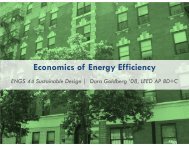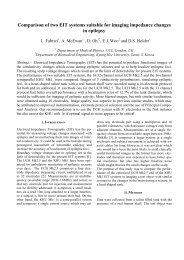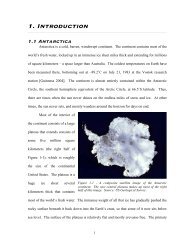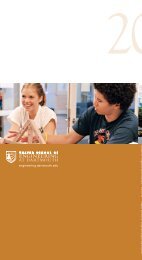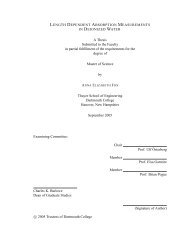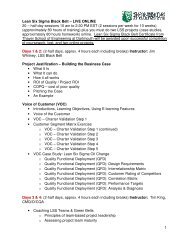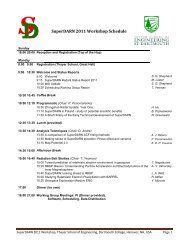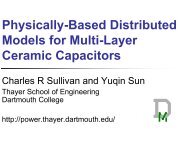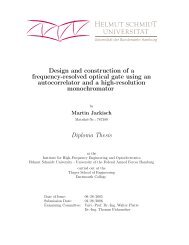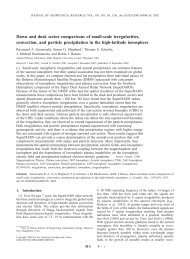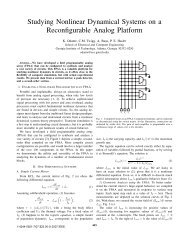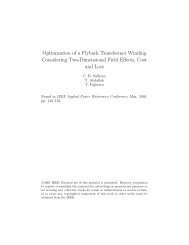Courses Programs - Thayer School of Engineering - Dartmouth ...
Courses Programs - Thayer School of Engineering - Dartmouth ...
Courses Programs - Thayer School of Engineering - Dartmouth ...
You also want an ePaper? Increase the reach of your titles
YUMPU automatically turns print PDFs into web optimized ePapers that Google loves.
undergraduate courses<br />
ENGS 30 Biological Physics<br />
(Identical to PHYS 30)<br />
Offered: 11S, 12S: 11<br />
Introduction to the principles <strong>of</strong> physics and engineering applied to biological problems.<br />
Topics include the architecture <strong>of</strong> biological cells, molecular motion, entropic<br />
forces, enzymes and molecular machines, and nerve impulses. Enrollment is limited<br />
to 20 students.<br />
Prerequisites: CHEM 5, PHYS 13 and 14 (or equivalent). PHYS 14 (or equivalent) may be<br />
taken concurrently. Students with strong quantitative skills who have taken PHYS 3 and 4<br />
can enroll with permission <strong>of</strong> the instructor.<br />
Instructor: Blencowe Dist: SCI<br />
ENGS 31 Digital Electronics<br />
(Identical to COSC 47)<br />
Offered: 11S, 12S: 12, laboratory 11X, 12X: 9L, laboratory<br />
This course teaches classical switching theory, including Boolean algebra, logic minimization,<br />
algorithmic state machine abstractions, and synchronous system design.<br />
This theory is then applied to digital electronic design. Techniques <strong>of</strong> logic implementation,<br />
from small scale integration (SSI) through application-specific integrated<br />
circuits (ASICs), are encountered. There are weekly laboratory exercises for the first<br />
part <strong>of</strong> the course, followed by a digital design project in which the student designs<br />
and builds a large system <strong>of</strong> his or her choice. In the process, computer-aided design<br />
(CAD) and construction techniques for digital systems are learned.<br />
Prerequisite: ENGS 20<br />
Instructors: Taylor (spring), Hansen (summer) Dist: TLA<br />
ENGS 32 Electronics: Introduction to Linear and Digital Circuits<br />
(Identical to PHYS 48)<br />
Offered: 11W, 12W: 11, laboratory<br />
Principles <strong>of</strong> operation <strong>of</strong> semiconductor diodes, bipolar and field-effect transistors,<br />
and their application in rectifier, amplifier, waveshaping, and logic circuits. Basic<br />
active-circuit theory. DC biasing and small-signal models. Introduction to integrated<br />
circuits: the operational amplifier and comparator. Emphasis on breadth <strong>of</strong> coverage<br />
<strong>of</strong> low-frequency linear and digital networks. Laboratory exercises permit “hands-on”<br />
experience in the analysis and design <strong>of</strong> simple electronic circuits. The course is<br />
designed for two populations: a) those desiring a single course in basic electronics,<br />
and b) those desiring the fundamentals necessary for further study <strong>of</strong> active circuits<br />
and systems.<br />
Prerequisite: ENGS 22 or equivalent background in basic circuit theory<br />
Instructor: Odame Dist: TLA<br />
ENGS 33 Solid Mechanics<br />
Offered: 10F, 11F: 9L, laboratory 11X, 12X: 12, laboratory<br />
After a brief review <strong>of</strong> the concepts <strong>of</strong> rigid body statics, the field equations describing<br />
the static behavior <strong>of</strong> deformable elastic solids are developed. The stress and strain<br />
tensors are introduced and utilized in the development. Exact and approximate solutions<br />
<strong>of</strong> the field equations are used in the study <strong>of</strong> common loading cases, including<br />
tension/compression, bending, torsion, pressure, and combinations <strong>of</strong> these.<br />
In the laboratory phase <strong>of</strong> the course, various methods <strong>of</strong> experimental solid<br />
mechanics are introduced. Some <strong>of</strong> these methods are used in a project in which the<br />
deformation and stress in an actual load system are determined and compared with<br />
theoretical predictions. The course includes a series <strong>of</strong> computer exercises designed to<br />
enhance the student’s understanding <strong>of</strong> the principles <strong>of</strong> solid mechanics.<br />
Prerequisites: MATH 13, PHYS 13, and ENGS 20 or COSC 5<br />
Instructors: May (fall), Diamond (summer) Dist: TLA<br />
71



